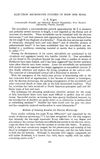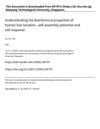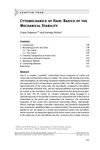TLDR Oxidized trichocyte keratin has a helical dislocation in its structure.
The study provided direct evidence supporting the existence of a helical dislocation in the intermediate filaments (IF) of oxidized trichocyte keratin. It demonstrated that during the assembly of trichocyte IF, the formation of disulfide linkages disrupted the structure present in the reduced state, leading to a helical dislocation similar to that found in certain microtubular structures. The research used a 1-D Patterson projection to confirm the presence of a surface lattice with specific dimensions, reinforcing previous proposals about the structural changes occurring between reduced and oxidized states. The findings highlighted that the end domains of IF molecules in the oxidized structure were in closer proximity than in the reduced structure.
7 citations
,
January 2017 in “Sub-cellular biochemistry/Subcellular biochemistry” 46 citations
,
June 2013 in “Journal of structural biology” High glycine–tyrosine keratin-associated proteins help make hair strong and maintain its shape.
39 citations
,
June 2012 in “Journal of Structural Biology” Disulfide bonds are crucial for hair structure during keratinization.
52 citations
,
April 2012 in “Journal of Investigative Dermatology” KRTAP2 genes are crucial for hair structure and may impact hair disorders and treatments.
31 citations
,
February 2007 in “Journal of Structural Biology” Oxidation changes the structure of hair protein filaments, causing them to compact and rearrange.
23 citations
,
April 2003 in “Journal of Structural Biology” Keratin structure changes during keratinization, but the exact model remains uncertain.
48 citations
,
January 2002 in “Journal of Structural Biology” 91 citations
,
December 2000 in “The journal of cell biology/The Journal of cell biology” Scientists successfully created mouse hair proteins in the lab, which are stable and similar to natural hair.
 191 citations
,
November 1959 in “Annals of the New York Academy of Sciences”
191 citations
,
November 1959 in “Annals of the New York Academy of Sciences” Hair and wool have complex microscopic structures with microfibrils and varying cystine content.

Human hair keratins can self-assemble and support cell growth, useful for biomedical applications.
39 citations
,
June 2012 in “Journal of Structural Biology” Disulfide bonds are crucial for hair structure during keratinization.
 38 citations
,
October 2011 in “Analytical biochemistry”
38 citations
,
October 2011 in “Analytical biochemistry” Hair proteins have weak spots in their α-helical segments.
 19 citations
,
January 2009 in “International review of cell and molecular biology”
19 citations
,
January 2009 in “International review of cell and molecular biology” Hair's strength and flexibility come from its protein structure and molecular interactions.
 1 citations
,
February 2013 in “InTech eBooks”
1 citations
,
February 2013 in “InTech eBooks” Genetic mutations cause various hair diseases, and whole genome sequencing may reveal more about these conditions.




